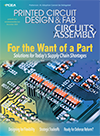News
PEACHTREE CITY, GA – December 11, 2025 – The exhibition floor for PCB West 2026 is now open to any prospective exhibitor, the Printed Circuit Engineering Association (PCEA) announced today. The exhibit floor is expected to sell out, as it has in 11 of the past 12 years, PCEA added.
HELSINKI – Scanfil has finalized its acquisition of US-based electronics manufacturer ADCO Circuits after securing approval from American regulators, the company confirmed Wednesday. The deal, first announced in June, marks a major expansion of Scanfil’s presence in the Americas and strengthens its position in the aerospace and defense supply chain – segments that accounted for 37% of ADCO’s 2024 revenue.
PEACHTREE CITY, GA – December 9, 2025 – The exhibition floor space for PCB East 2026 is more than 70% booked and is expected to sell out, the Printed Circuit Engineering Association (PCEA) said today.
Press Releases
- Mobius Materials Raises $3M to Combat One of Manufacturing’s Biggest Issues Amid US-China Trade Tariffs
- Kitron secures EUR 17 million contract for combat vehicle components
- Altus Reports Growing Demand for Guidance on Convection Reflow Oven Specification
- Coherix Opens New Adhesive-Dispensing Vision Center in Europe


